


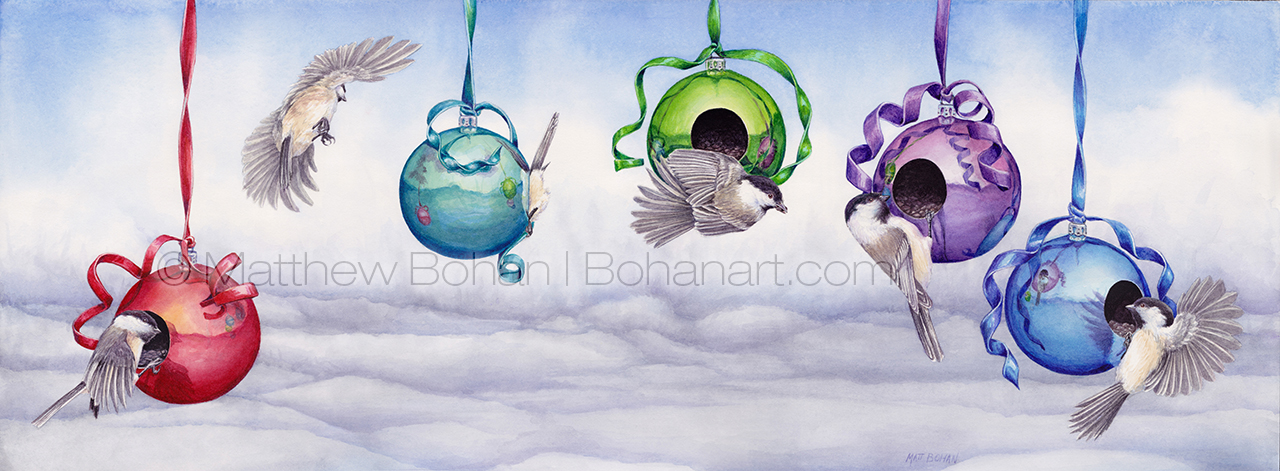
What is more endearing than a Chickadee? Being undeniably cute and having a cheery disposition are a great combination. We have a steady flow of these birds at our feeders year round. A few years ago I saw some big plastic Christmas ornaments at Menard’s for a dollar each and had the idea of drilling a hole in each to make a feeder. I thought I’d be able to get some cool shots of the birds next to the ornaments. Chickadees, being little acrobats, figured them out within a day, making the ornament feeders a big hit with the birds and humans alike. Getting good photos proved much more difficult, as the chickadees seem to move at the speed of subatomic particles. A few hundred attempts resulted in perhaps a dozen decent shots.
My first attempts at converting the ornaments into feeders were functional, but version 3.0 was the best, incorporating drainage holes and glued-in screening to prevent seed spoilage. Some birds species aren’t skilled enough to enter the swinging feeders. Fortunately, House Sparrows and House Finches seem thwarted. Chickadees are masters of shooting in and out; titmice and goldfinches are runners up. An unexpected bonus of the ornament feeders is that on snowy days, the chickadees knock out a fairly constant supply of seeds for the ground feeders, like Mourning Doves and Dark-eyed Juncos, so everyone ends up winning.
I had the idea for this painting for a long time before executing it. I ended up compiling a bunch of different photos and sketched into one piece. To get the ornaments and ribbons in just the right places and colors for the painting I sculpted those in Lightwave 3d and rendered them out in the corrected positions for my Chickadee references. I the experimented with a myriad of colors, positions of birds and ornaments before settling on a long thin horizontal design.
This painting was close to being scrapped in the early stages. I was completely unhappy with my initial background wash. One of my big brushes must have had a clump of unmixed paint stuck to it, and it left a nasty dark streak in what I had hoped would be a super-soft, blurry background suggesting snowfall and sky. I was unable to lift any of the pigment with soft, wet scrubbing. That mark was there to stay. Disheartened, I put it away until the next day. I was hoping to feel more optimistic after a night of sleep but planned to cut my losses and start over. In the morning it didn’t look quite as bad, and it seemed worthy of a bit of time to see if I could work the streak into a more detailed background than I initially planned. In the end I had something that looked different than planned but still workable. Once I started on the detail work, the background didn’t bother me as much. It was fun to work on some glossy metallics in this painting. It had been a while since I did things other than feathers, leaves, scales and fur in watercolor.
I ended up calling it quits on the painting but was never completely satisfied with the background. After it sat in a drawer of my flat files for nine months, I pulled it out to see if the background still disappointed. Yup. After a week or two of thinking about it, I decided to pull out the airbrush and fix up the background. Even if I ruined the painting, I still had a good scan of the previous disappointment. It was worth the risk. I spent a few hours cutting out frisket film to cover the painted birds and ornaments, then I got out the compressor, hoses, airbrush and respirator and went about spraying in a new background. I wish I could say it went by without a hitch, but it has been a few years since I used the airbrush, and I mixed the paints a little too wet, which caused some seeping under the frisket masking the birds. (!) If that weren’t enough, the paint took on a pebbly texture in other areas. This one wasn’t giving up easily. It was a bit of a fight from the beginning to the end. Once the main background was lightened up, I spattered in some “snow” with a toothbrush and white paint. Once it was completely dry, I was able to burnish the bumpy texture away with a piece of tracing paper and a folding bone. It took nine months, but I finally ended up with something I was happy with. I honestly felt like using the airbrush was cheating, but in the end it was the tool that could bring the art back more in line with what I had initially envisioned.
Often I find that I learn the most when things don’t quite go as planned and I have to adapt and improvise to the situation to find a solution. That certainly was the case with this painting. I’m glad I hung in there to see it through to the end. I thought I was finished with this one about four times and went as far as scanning the “completed” work only to find that once I saw it onscreen, there were still things that bothered me and needed to be revisited. I don’t know about other artists, but I can point to something in virtually every painting I’ve done that bothers me. I’m not a total pessimist; I just always see areas to improve upon.


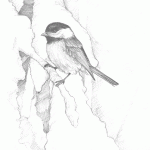

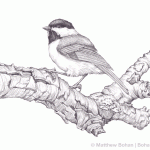
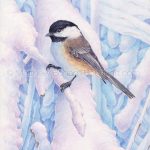
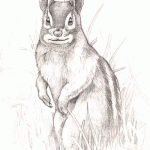
Leave a Reply